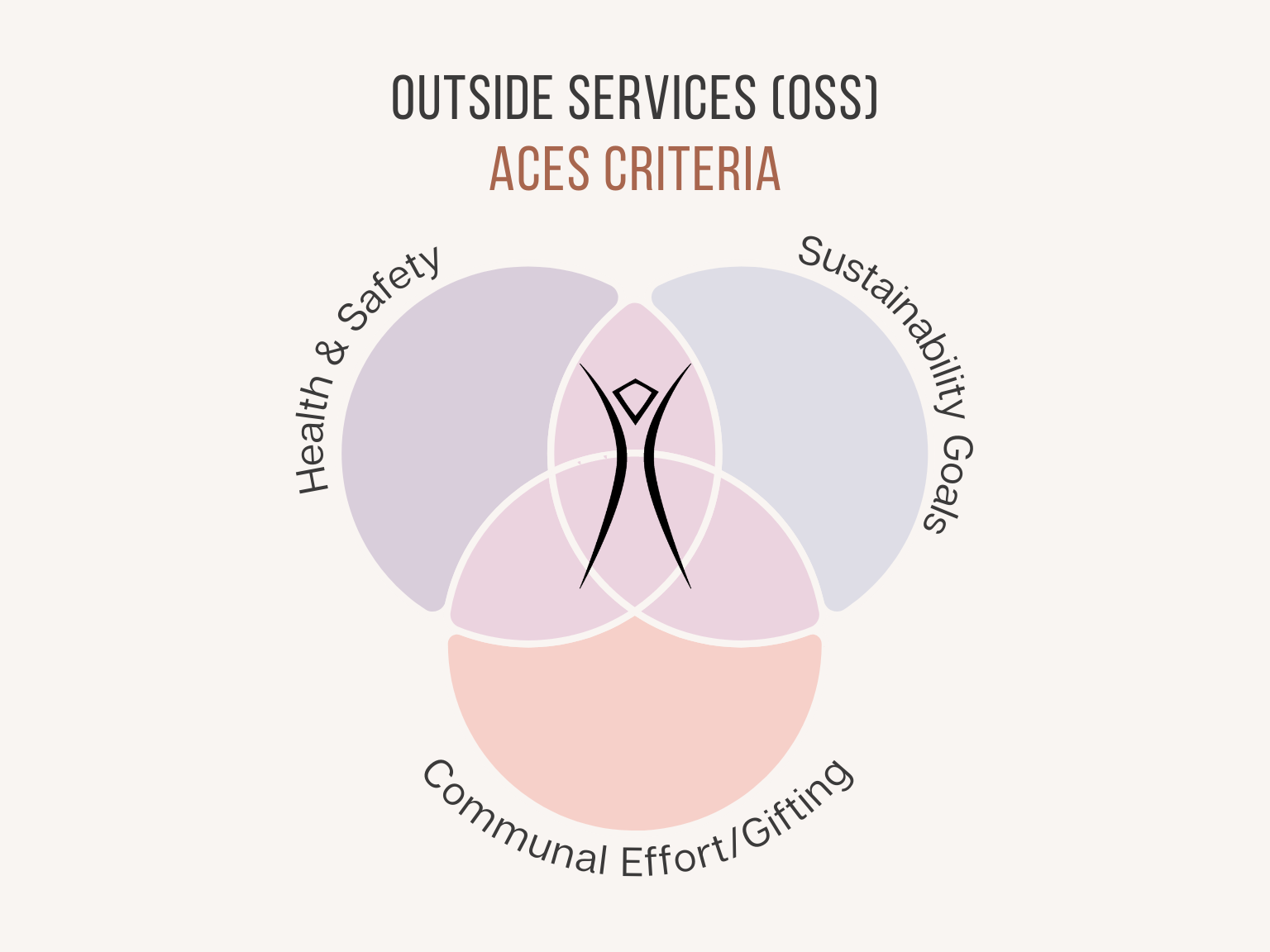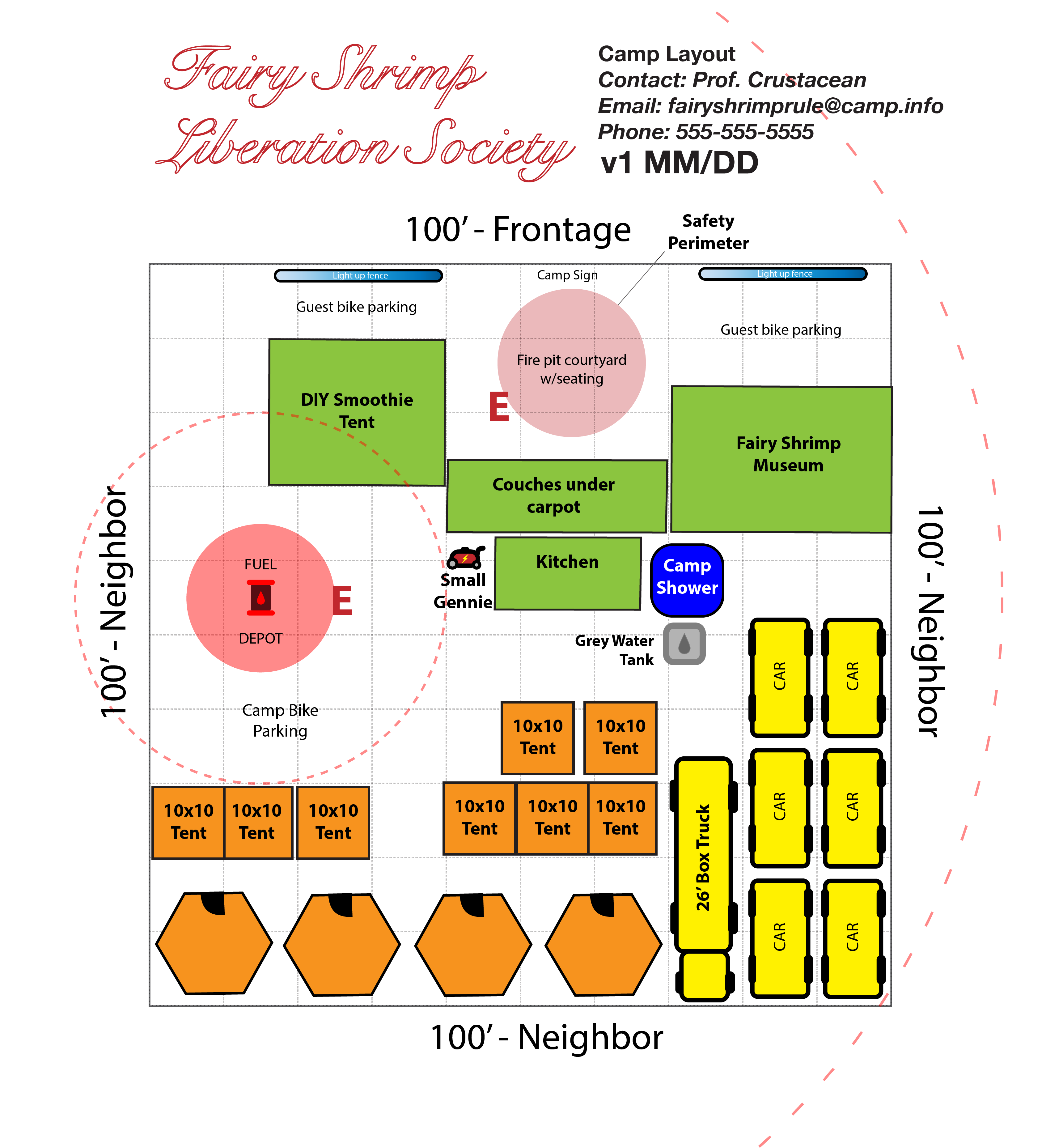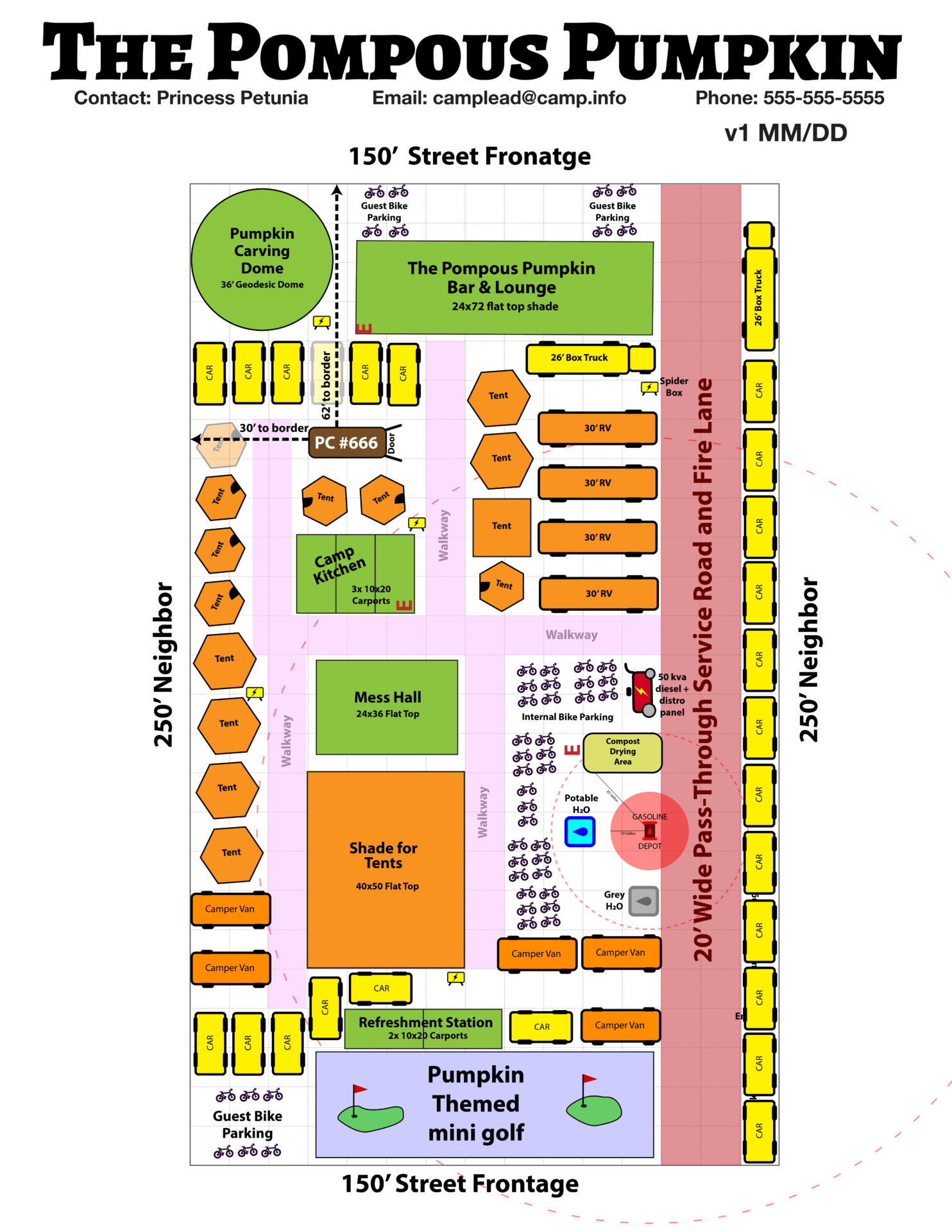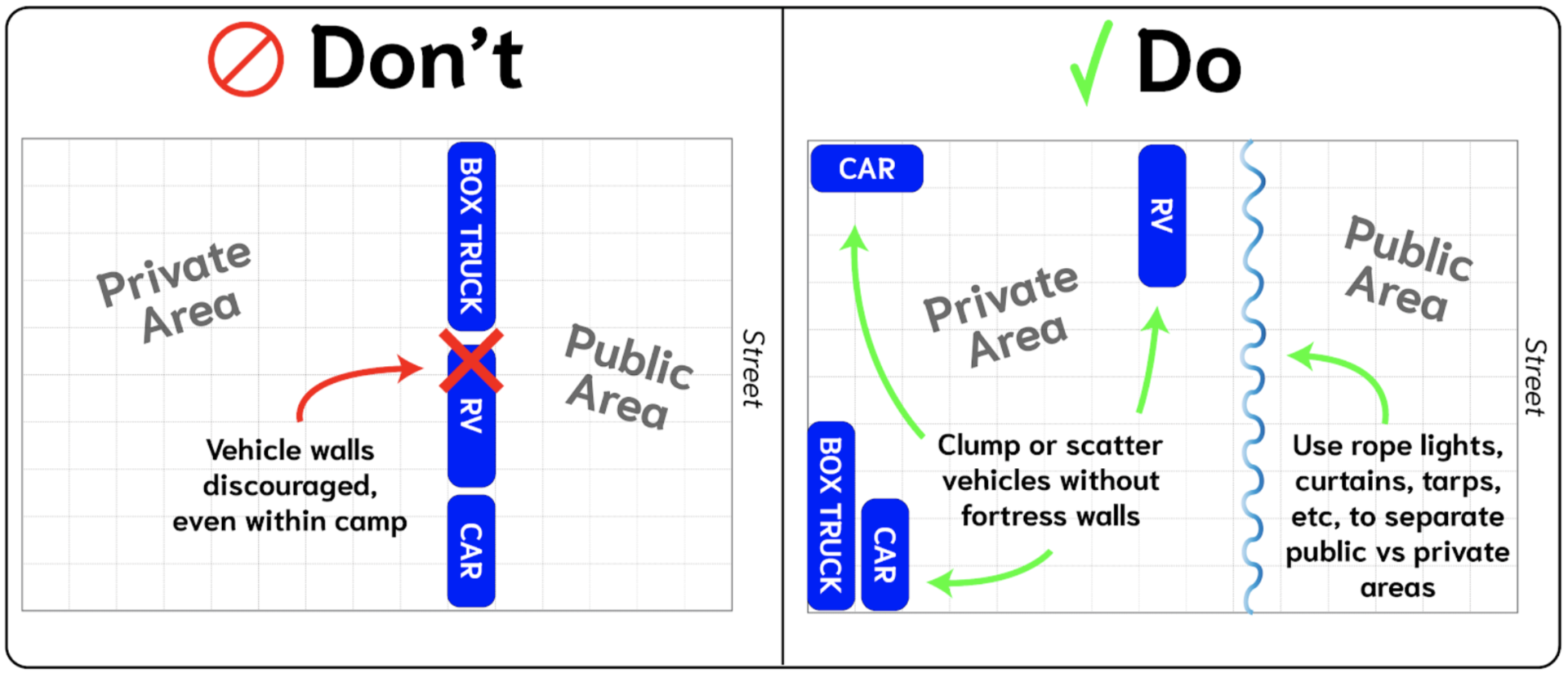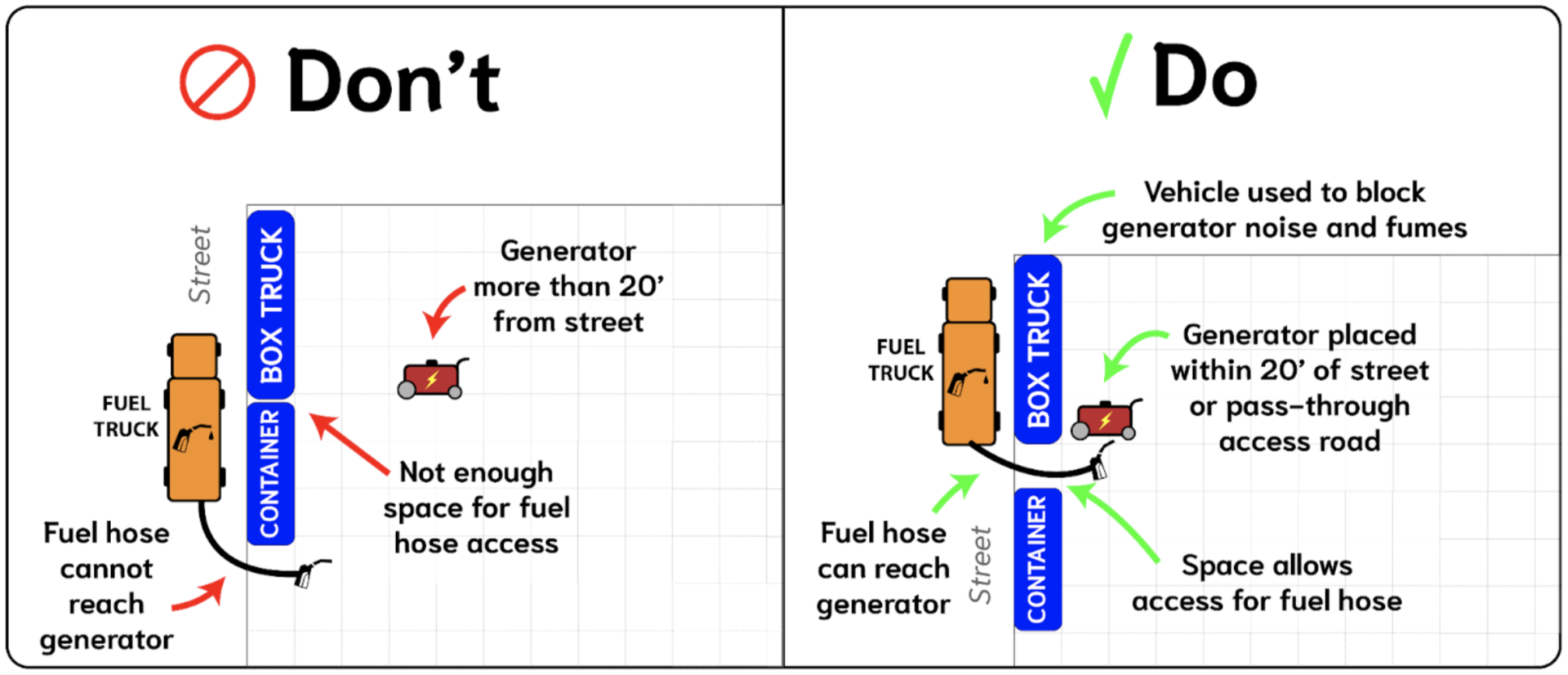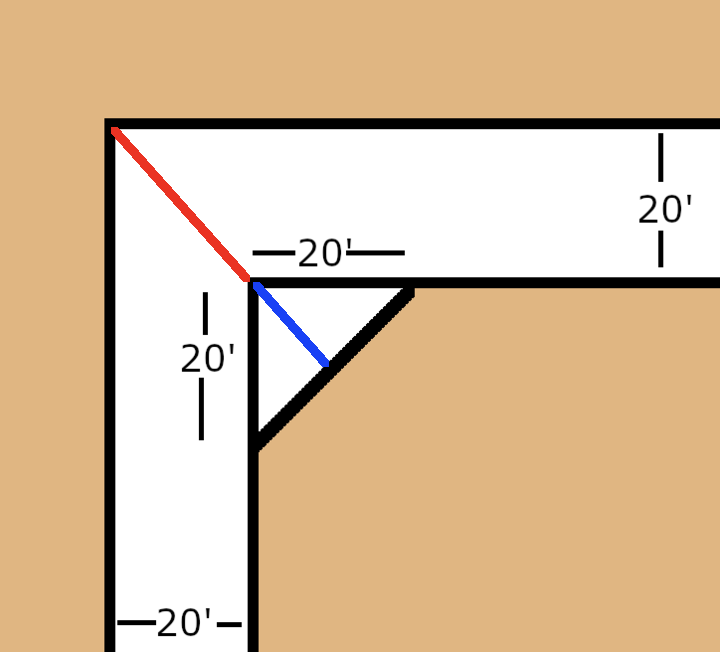This guide will support your efforts to organize amazing camps. Although some of this information is specific to theme camps and villages, most will also be relevant to camps of all types and sizes. If you prefer to watch rather than read, we’ve included relevant Camp Symposium videos and additional resources. This info is maintained by the Camp Support Team.
Before you dive in, note that there is no one way to camp at Burning Man. Each of the 1,500 Black Rock City camps has its own way of doing things! These resources and advice are here to support you on your journey.
Organizing and Leading a Camp
- Acculturation of Camp Members
Acculturation of Camp Members
Camps play a critical role in acculturating their members for Burning Man, including:
- acculturating newbies to Burning Man culture, Black Rock City (BRC), and to your camp
- acculturating returning Burners who are new to your camp or your camp’s culture
- sometimes re-acculturating veteran Burners and reminding them how Burning Man and your camp are different from the default world.
At the most basic level, acculturation is easier or more challenging depending on ratios of new Burners to veterans. For example, if 5-10% of your camp are newbies or new Burners to your camp, it’s fairly easy for the camp leadership and other campmates to support their acculturation journey. If over 50% of your camp are newbies and/or Burners who are new to your camp, acculturation will be much more challenging. Newbie sponsorship by a veteran campmate to guide the newbie through acculturation both pre-Playa and on Playa ensures that important information is shared and the newbie is supported in the experience. Here is a 2019 Theme Camp Symposium video: Acculturation Panel
Burning Man Culture: How do we introduce those who are on playa for the first time to our city and community? The 10 Principles were created as guidance to help all of us navigate Black Rock City and Burning Man culture around the world. They are a great place to start when bringing new friends to Black Rock City, but it’s important to note the 10 Principles are intentionally descriptive instead of prescriptive. It’s up to each of us to interpret the 10 Principles, so the more you can encourage your campmates to genuinely think about, engage with, and apply them in their own way, the more helpful it will be than telling them how they “should” interpret them.
Black Rock City Culture: Acculturating your campmates to the unique ways we are together in Black Rock City intersects with the 10 Principles. Introduce newbies to the Survival Guide, which includes tips for how to be a good citizen of BRC, dos and don’ts, and the community resources that they won’t find in the default world. As their camp, you have a huge opportunity to affect individual behavior through the education you do up front, the expectations you set around behavior, and how you respond when something happens that isn’t in line with the culture. Consider covering topics like how to take care of your well-being, Leave No Trace, consent (including consent to be photographed, hugged, or given a gift), logos and branding, porta-potty etiquette, encouraging participation, and how to be a good neighbor.
Your Camp’s Culture: Every camp is unique! How are you different from other camps? What do newbies or Burners who are new to your camp need to know to align with your camp’s culture? What expectations do you have of each other when it comes to participation with visitors to your camp and also ensuring your camp will run smoothly? What happens if those expectations aren’t met?
Acculturation Checklist:
- Burning Man culture
- Make sure your campers understand the 10 Principles.
- Watch this video and look for others that explain the culture and ethos of Burning Man.
- Discuss some of the more nuanced Principles that may be more difficult for new people to “get” about Burning Man’s culture like the importance of Decommodification and how seriously we take Leave No Trace. Paint a picture of what the Principles look like in action and why they matter to you.
- Black Rock City culture
- Check that they’ve read the Survival Guide.
- Encourage them to explore information about the event.
- Establish how they can get support and who can help them when they are figuring out how to go to Black Rock City and/or be part of your camp for the first time.
- Your camp’s culture
- Get clear on your own camp’s culture and values. What sets your camp apart?
- Explain how you operate together, and how you communicate with new campers.
- Set clear and specific expectations with campers for participation before and during the event, and for strike and post-event, if applicable.
- Make these expectations easily available in a written document.
Additional Resources:
- 2023 Camp Symposium Growing Your Camp – Attracting, Acculturating & Building a Culture of Community
- 2020 Theme Camp Symposium — Putting the ‘Cult’ in Acculturation
- 2019 Theme Camp Symposium — Acculturation Panel
- 2018 Theme Camp Symposium — How To Herd Cats and Cultivate Campmates: Lessons in Acculturation
- 2016 Theme Camp Symposium — Theme Campers as Acculturators
- Consent
Consent
Build, maintain, and promote a culture of consent in your camp. The 5 tips below are a start on your journey of practicing, integrating, and respecting consent. More information and resources can be found at Tips and guidelines for consent at Burning Man and Sexual Misconduct Awareness, Education, and Prevention. View the recording of the Campfire Talk on the topic of consent here: Expanding Consent Beyond Sex.
5 Tips for Helping Prevent Sexual Harassment at Burning Man (from Burning Man Journal)
- Do not make unsolicited sexual remarks or comments about someone else’s body.
However it’s intended, unsolicited sexual comments about somebody else’s body may not feel like a compliment to the person you’re saying them to.
- Don’t touch anyone without their enthusiastic consent.
Respecting personal boundaries is key. This also goes for touches that aren’t intended to be sexual.
- Don’t take photos of someone without their enthusiastic consent.
You might be surprised how often fellow BRC citizens seem to think this doesn’t apply to women they find attractive. No amount of clothing (or lack thereof) makes it okay to snap a photo without asking, period.
- Don’t treat someone else’s body like a commodity without their enthusiastic consent.
Ever been to a bar camp where men drink for “free” but women have to flash the servers? Using other people’s bodies like currency is a form of objectification, and (unless they’re into that) it’s not cool.
- Always take “no” for an answer.
Sometimes, the friendliest, sexiest thing you can do is respect someone else’s boundaries. If they say “no thanks” to any of the above, don’t push the issue and don’t get mad. Rather, say “thank you” for their clear communication of what they do and don’t want.
Each and every one of us is responsible for helping make Black Rock City a safe, welcoming place for all its citizens. Keep these tips in mind and share them with your friends and campmates. Everyone can be part of the solution!
Additional Resources:
Tips and guidelines for consent at Burning Man
Sexual Misconduct Awareness, Education, and Prevention.
Campfire Talk: Expanding Sex Beyond Consent
2023 Camp Symposium: Consent – How to Acculturate Camp Members and Teach Camp Guests
- Leadership
Leadership
Managing a camp comes with all of the fun and challenges that accompany any project that brings people, infrastructure, and creative spirit together. For a bit of inspiration, watch this video of fellow camp leaders at the 2018 Theme Camp Symposium explaining why they do all they do for their camps.
- Communication
- Leaders communicate expectations, needs, challenges, ideas, plans, requests, opportunities, decisions, and much more. What does the communication loop between your camp’s leadership and the rest of your camp look like? Whether you use email, social media, or collaboration applications, make sure everyone can access important information and announcements in a timely manner.
- Many camps have in-person or virtual meetings throughout the year to discuss ideas, make decisions, and build community. Find the frequency and method that works best for your camp.
- Managing people
- Friends
- There are many different approaches for leading groups of friends. Openly communicating, staying honest, and speaking up as early as possible when something isn’t working is probably the best advice. If you wait too long and frustration builds, your camp stuff can taint your friendship.
- Friends of friends
- If managing friends is challenging, managing the friends they want to bring with them can be even more so. There’s a common theme when dealing with people, friends or otherwise. Open and honest communication is key.
- New friends
- Sometimes you bring in total strangers to your camp. There are various reasons to do so and none of them change how you lead them. As a general rule, the more communication with new camp members before getting to the playa, the better.
- Friends
- Appreciating campers
- Providing feedback is vital. It is sometimes easy to forget what a powerful force positive feedback can be. It can be easy to focus on the things that are going wrong, especially in the midst of camp build or teardown. Remind the people around you that you appreciate them and that their contributions are important. A little praise goes a looooong way. And we hope they’ll appreciate you too!
- Cultivating new leaders
- At some point in time, for some reason you may not be able to fulfill a leadership role in your camp. Life happens, burn-out happens, and if you want your camp to continue, you should think about who might take over for you should you step aside. Share responsibility often so you can identify who is willing and able to be that new leader.
- Empowerment
- Does someone have a great idea? Rather than the established leaders taking it on, let the suggestor make it happen! Even if they don’t have the skills, experience, or track record, what better place than Burning Man for someone to take on a project they’re excited about and figure out how to do it? Provide support and mentorship as needed, but let them run with it.
- Burn-out
- Organizing and managing a Burning Man theme camp or village is hard. There comes a point where everyone needs a break and that’s OK. To avoid burn-out, spread as much of the responsibility around as possible. By sharing the load, you can hang in there a lot longer.
- Support networks
- Although your camp is your primary support network, sometimes you need advice from experienced camp leaders outside of your group. There are multiple resources for you to access when you need a little extra encouragement or friendly advice:
- Additional Resources:
- 2023 Camp Symposium: Nothing Succeeds Like Success: How to Start & Maintain a Healthy Camp
-
Campfire Talk: Camp Leadership Systems: Main Talk and Village Breakout, Small Camps Breakout, Midsize Camps Breakout
- Communication
- Conflict Resolution
Conflict Resolution
Conflict is part of personal and group growth, but we always want to keep it constructive. Disagreements arise during planning and when you are at BRC. Be prepared so that conflicts don’t get past the point where they can be respectfully managed.
A simple conflict resolution plan should be made available for everyone to review and should include defined steps to resolution and an escalation path for more serious conflicts. Post it somewhere accessible to all. Many camps have a member who has been trained in mediation or conflict management and resolution. Take advantage of their skills.
Additional Resources:
Camp Symposium 2023: Conflict Mediation Training – How to Win a Goat Rodeo
Camp Symposium 2022: Leadership and Planning Conflict Prevention, Engagement, and Resolution
- Camp Finances
Camp Finances
Small camps (e.g, fewer than 10 members) may not have a shared budget. In a small camp, each member may simply bring whatever resources they have to share. However, most larger camps require members to contribute dues, which might be as little as $50 per person, up to $500 per person or more to make sharing resources within the camp easier to manage. Examples of major expenses for a large camp include: purchase of shade structures, equipment and vehicle rental, communal kitchen supplies, materials for art projects or interactivity plans, storage costs, and the cost of producing high quality swag.
Experience has shown that it is best to have a designated camp treasurer who collects the dues and manages the camp budget. It is the treasurer’s responsibility to collect dues from everyone before getting to the playa, and to maintain an up to date report on camp expenditures.
Additional Resources:
2023 Camp Symposium: The Pros and Cons of Dues, Deposits, and Other Financial Structures to Motivate Your Camp
2022 Camp Symposium: Finances- Keeping Your Camp in the Black
- Fundraising and Burning Man's Intellectual Property
Fundraising and Burning Man’s Intellectual Property
What happens when your ideas grow so big you need to find additional capital to make that idea a reality? Fortunately our community likes to support big ideas, but how do you ask for donations without stepping into any weird legal issues or Decommodification quagmires? Read on to find out more about Burning Man’s IP (intellectual property) and how to decommodify your camp’s fundraising efforts.
This summary includes:
- An overview of Burning Man’s IP and image-use policies — and why we care!
- Gifting items with Burning Man’s IP or images from BRC
- Hosting a fundraising event
- Other tips for keeping your fundraising decommodified.
1. Burning Man’s Policies
- IP and image-use policies are guided by the Ten Principles and aimed at protecting the event, our participants, and the core words and symbols of Burner culture from commercial exploitation.
- The core trademarks that Burning Man protects are: the Burning Man symbol (logo), “Burning Man,” “Black Rock City,” and “Decompression.”
- Burning Man protects the copyrights for the design of the Man, the design of the Black Rock City map, and the 10 Principles.
- We also restrict the commercial use of Burning Man images to protect the event and the privacy of our participants, in service to Decommodification, Radical Self-expression, Immediacy, Participation… Non-personal use of images taken at the event must be approved by Burning Man (typically the Communications team — press@burningman.org).
2. Gifting Items With Burning Man’s IP or Images from BRC
The Burner community is encouraged to incorporate Burning Man IP or images into their BRC artwork and gifts according to these guidelines:
Totally OK: GIFTING
- Theme camps, mutant vehicles and art installations are gifts to all of Black Rock City. Burning Man participants are welcome to GIFT items that incorporate Burning Man’s trademarks or copyrights as tokens of appreciation to people who support these playa-bound projects, including as “rewards” or “perks” in crowdfunding campaigns.
- Example: Incorporating the Man symbol or “Burning Man 2018” into your camp or art project logo, and printing it on gifts for people who support your fundraiser — OK!
- If you’re going to use the Man symbol on a pledge gift, be radically self-expressive and create a custom variation that suits your project!
Not OK: SELLING
- You can’t SELL items with Burning Man trademarks, copyrights, or images in any forum, including on peer-to-peer websites like eBay, Etsy, Cafe Press, etc.
- Example: Setting up an online shop for your camp with merchandise that incorporates the Man symbol, “Burning Man” or “Black Rock City” — NOT OK!
- If you create gifts that incorporate a Burning Man trademark, copyright or image and you have some left after the event, you can’t sell those leftovers. Likewise, please don’t fundraise for the costs of producing your gifts — that’s like selling them for the amount of the donation.
- Example: Setting up a crowdfunding campaign for the Man symbol jewelry you want to gift at Burning Man this year — NOT OK!
3. Hosting a Fundraising Event
- If you’re having a fundraising event for your camp or other BRC-bound project, feel free to use “Burning Man” or “Black Rock City” in the event description. Just don’t use these names in ways that suggest the Burning Man organization is hosting or sponsoring your event.
- “Decompression” should not be used in connection with your fundraisers. This name is reserved for events produced by Burning Man or the Burning Man Regional Network.
- Examples: Saying your fundraiser is for your camp “at Burning Man” or your art project “in Black Rock City” — OK!
- Calling your event a “Burning Man Fundraiser” or “Decompression Party” — NOT OK!
4. Other Tips for Keeping Your Fundraising Decommodified
Avoid commodifying the Burning Man experience:
- Steer clear of offering “VIP” access in exchange for donations — a private tour on your Mutant Vehicle, a private party at your camp, etc.
- REMINDER: Burning Man tickets and vehicle passes can’t be used for fundraising purposes (including as crowdfunding rewards, in auctions, etc.)
Avoid commodifying camp space:
- Pooling resources and sharing costs with your friends — OK!
- Selling space in your camp to raise money — NOT OK!
You can read more on Burning Man’s approach to intellectual property, trademarks and copyrights here, as well as proper use of images and media rights here.
If you see any questionable uses of Burning Man’s IP or imagery, please let us know — ip@burningman.org. We appreciate your help!
Additional Resources:
- Camp Symposium 2016: Legal, Fundraising, IP: Burning Man Theme Camp Guide
- Camp Size
Camp Size
Every year Black Rock City is completely rebuilt and with that comes many changes. Camps grow, camps shrink, camps hibernate for a season, camps wake up. Know what to expect so your camp can navigate inevitable changes in population or enthusiasm.
- Growth: Sometimes bigger is not better. As a camp lead, it’s super important that you understand your willingness and ability to manage an ever-growing population of campers. It can be challenging when your camp starts as a group of friends, and then the next year everyone wants to invite another friend, and then the year after that they all want to invite their friends, and all of a sudden your camp has doubled or tripled in size. Slow growth is typically the most successful strategy and it helps to have some intention around the maximum size for your camp.
- Size thresholds: There are many theories regarding group sizes and the thresholds at which dynamics and complexity changes substantially. If you’re interested, we’d suggest looking up some of the research. One number that’s cited often by camp leaders is Dunbar’s Number, a theory that humans can only comfortably hold up to 150 relationships. There are thresholds at smaller group sizes as well.
- Limiting size: The best time to discuss limiting the size of your camp is during the event. Ask the question, is our camp the right size, or should we grow? If the answer to that question is, “We are the right size now”, then start the conversation about how to restrict camp membership next year.
- Downsizing: Despite our best efforts, life happens in between burns and your once thriving and robust camp may find itself with campers who are not able to make the trip to the desert. Don’t panic! You can do this. It’s totally acceptable to scale back your interactivity offerings should you find yourself with fewer people to make it happen. Keep the potential of future downsizing or size fluctuations in mind as your camp is growing. Sometimes a temporary solution to accommodate more people for one year makes more sense than permanent infrastructure that you find you don’t need next year.
- Take a year off: After 15 years of serving grilled carrots and candy bar smoothies you deserve a break! Sometimes a camp just needs to take a breather. If you’re a placed theme camp, you will find Placement happy to work with you and hold your camp in good standing during your break. You have to let Placement know before the Statement of Intent is due, which is typically in January.
Managing Playa Logistics
Living in the desert for a week or two takes some planning. Not only do you have to get all of your stuff there, but you need to know where it goes once you arrive. You should know roughly how much space you need, how best to arrange things, and how to light it up so nobody trips/rides over your stuff in the dark of night. Layout essentials Space Allocation Ingress/egress Your Sides and RV Walls Emergency Access Fire, Fire Lanes, and Fire Safety Managing Parking (or, creative vehicle placement) Accessibility Preparing for Extreme Weather The Black Rock Desert is wild and unpredictable. High winds, rain, lightning, hail, extreme heat, and near freezing cold are all possibilities during the event. Your camp should have plans in place for all weather conditions. Additional Resources: There’s a lot to consider to make sure the structure you’re building on playa is safe. Large structures need to be secured properly. All designs are strongly advised to include safety provisions. For more information on building safe and secure structures for your camp, check out Securing Your Structure. If you’re building an art project, Building Safe Structures, is a handy guide. Additional Resources: Most of the time we find our neighbors in Black Rock City to be wonderful, supportive, funny, and welcoming, but every so often there’s a little friction between camps. Ninety-nine percent of the time, issues are resolved with open and respectful communication. Additional Resources: Theme camps form the heart of Black Rock City. Big, small, loud, quiet, these are the places created to entertain, entice, and inform the citizenry. Interactivity is a key component to a successful theme camp and its definition is, thankfully, broad. Frontage (or visual stimulation, or curb appeal) is also an important aspect of being a theme camp. Note: Interactivity and frontage are not criteria for other camp categories. This only applies to theme camps requesting placement. While it may not be required for your camp category, it sure is lovely to provide interactive experiences for your neighbors regardless! And there are many theme camps in open camping who prefer not to be placed. Additional Resources: Nobody wants to get sick out there and nobody wants to make others sick. To prevent foodborne illness on the playa, the Central Nevada Health District (CNHD) has requirements for camps serving food or beverages, including the need for a health permit. You must apply to the CNHD and be permitted as a Temporary Food Establishment if: You can find information about this year’s application and deadlines on the CNHD website here. If you have a communal kitchen shared by 125 or more campers but meals are prepared individually or in smaller quantities than for 125 persons, a permit is not required. However, we highly recommend you research and review the videos on the site and the “Burning Man Self Checklist” found on the CNHD website’s information page. There are many ways to structure a kitchen. Some camps have communal meal plans (some do one meal, two meals, or three meals per day), some camps share groceries but individuals make their own food, and some camps do not collaborate on food. The amount of infrastructure and equipment you’ll need for your kitchen depends on the size of your camp and how extensive or simple your food plans are. Additional Resources: Here’s a roundup of key safety information: Videos: Black Rock City is a pedestrian-friendly environment that lends itself to walking and biking. Bikes are the most popular mode of transportation on the playa and that means there are a lot of them! Bikes are super useful but, on occasion, they become problematic. Sound Policy: Sound Recommendations: We also wanted to share the below fantastic sound recommendations from Noah Reson-Brown from the Theme Camp Cult of the Magic Lady. We’ve shortened it slightly below for this format., The original post online is here. Remember, you too can avoid noise complaints! There is an entire page devoted to generators! Check out the Generators page for tips on using a genny in your camp. The most important aspect for camps to consider (beyond the power itself) is how your generator will impact your neighbors. Where are you placing the generator in the context of your camp? Rule of thumb for things that are unpleasant (generators, toilets, light towers, etc)—if your camp is going to enjoy the benefits, then your camp should also deal with the downsides of them (smell, noise, light, etc). Don’t place these things on your camp border so your neighbors have to deal with the downsides while you enjoy the conveniences. Try and put them as deep into your camp’s layout as possible. Additional Resources: Sometimes you make really big plans and will need to rely on Outside Services to deliver infrastructure into Black Rock City. Options available for arranging deliveries to the playa are explained on the Arranging Deliveries page. Our event could not exist without vigilant participants packing out their equipment, recyclables, trash, and everything else they brought with them. There’s a ton of information on our Leaving No Trace page that will help you manage your LNT efforts! Note that your camp’s LNT history will be heavily weighted when evaluating future applications for placement. Additional Resources:Camp Layout and Logistics
Shade and Other Structures
Neighbors
Interactivity and Frontage
Kitchens and Food Safety
Camp Safety and Security
Bikes
Sound
Hey amplified sound camps with a DJ! Wanna avoid noise complaints? It’s doable… but there’s a method to the madness.
Generators and Power
Deliveries to Black Rock City
Leaving No Trace (LNT)
Other Resources
Once a year camp leaders get together to support each other and share ideas, challenges, and tactics for putting together the best possible camps. Campfire Talks We know that before the Man goes up in flames you’re already thinking about plans for next year, and fortunately you’re not alone. There are various resources that are active all year long where you can discuss your next big idea or give help to those who are just figuring this theme camp thing out.Camp Symposium
Campfire Talks is a monthly series hosted by Burning Man Project’s Camp Network Team comprised of volunteers from Black Rock City’s theme camp community. The series brings together theme camp organizers by the virtual campfire to feature their stories, share their knowledge, discuss timely topics, and to find new ways to connect.
Online Communities Directory


